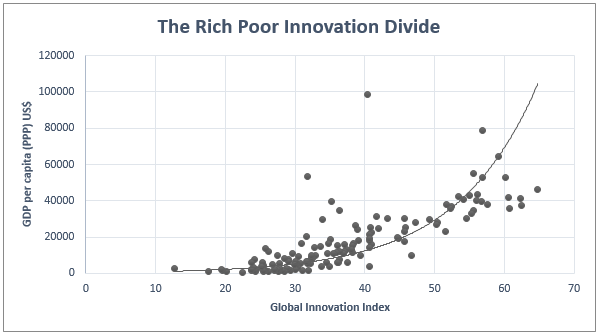
High income economies are dominating global innovation. Led by Switzerland, the top 10% are outpacing the rest in innovation as measured by the 2014 Global Innovation Index. This rich-poor innovation divide is striking with a handful of high income countries, mostly in Europe accounting for most of the top 10%. The bottom quintile consists of predominantly low income economies with more than half from Sub Saharan Africa.

The top innovating economies rate strongly on the quality of their institutions including a stable political environment and an effective regulatory and business environment. They benefit from and continue to invest heavily in human capital, research and development and infrastructure. They score highly on business and market sophistication – good management is fundamental for private sector innovation. They have also established most if not all of the elements of a successful innovation ecosystem. These countries consequently dominate in knowledge outputs including on most measures of knowledge creation, impact and diffusion as well as in technology and creative outputs.
It is difficult to imagine that poor countries or emerging markets without innovation will be able to catch up and become high-income economies in the 21st Century, an era already characterized by previously unimaginable technological progress and, importantly, international diffusion. Populations in these countries are in dire need of innovative solutions to deliver clean water and energy, health and education services, better housing, sanitation and transportation and increased food production while battling the adverse impacts of climate change. These economies need to create jobs for millions of unemployed youth leveraging the benefits of an increasingly digital global economy.
What can be done to bridge this yawning innovation and competitiveness gap?
- Increase investments in a shared global innovation agenda. The top innovating economies can do more to invest in developing a shared global innovation agenda that is central to reducing poverty and increasing shared prosperity in the low-income economies. This could include partnerships for sharing of best practices and collaborative research and development on issues such as food security and climate change. Developing countries need to make sure that universities are run as meritocracies, with good quality human capital, and tightly connected to the private sector. Good partners are needed in both ends for the agenda to work.
- Facilitate technology diffusion and adaptation. Overcoming barriers to innovation and establishing new mechanisms for transmission of knowledge and skills especially in scaling up workable solutions to benefit the poor is critical. Innovative solutions need to be adapted by local entrepreneurs for scalable programs. These networks of barefoot innovators need to be nurtured and supported from the ground up through programs for training, mentoring, coaching, networking and provision of support infrastructure, seed financing and in leveraging private investment funds for scaling up.
- Ensure unfettered flow of talent and knowledge. Flow of skilled individuals and knowledge is vital for global innovation while ensuring that more effective mechanisms are in place to strengthen collaboration, knowledge and experience exchange on developing effective national and regional innovation ecosystems. Emigration of human capital with a vocation for innovation from developing countries has a cost, but migrants can also act as innovation antennas, sending knowledge, capital and encouragement to younger generations of potential inventors in developing countries. The experience of Ireland and India attest to this.
- Use intellectual property rights to facilitate innovation for the poor. Intellectual property rights provide a strong incentive for the private sector to invest in innovation and technology adaptation – it may actually contribute to talent retention in developing countries. Trade-offs, including raising the costs of imitation, need to be assessed. Institutional strengthening for adequate implementation is required.
- Enhance innovation efficiency and connect innovation to markets.Merely increasing the total expenditure on research and development may be insufficient and perhaps not even wise given the many competing demands for countries’ fiscal resources. A comprehensive assessment of the gaps in the innovation and entrepreneurship ecosystem, targeted interventions to improve outputs of institutions and prioritization of investments especially leveraging private sector ingenuity and resources are likely to yield better outcomes. In this context, nurturing good management is key.
There is encouraging evidence that the small early efforts are starting to pay off. The Global Innovation Index report concludes that Sub Saharan Africa saw the most significant improvement in rankings in 2014 with five countries (Burkina Faso, Gambia, Malawi, Mozambique and Rwanda) classified as innovation learners (economies that perform at least 10% higher than expected for their level of GDP).
There is a generation of young entrepreneurs in low income economies which is well equipped and motivated to develop innovative solutions in areas such as digital, climate resilience, creative and agribusiness technologies. This growing pool of human capital is talented and resourceful. Harnessing the potential of this talent is our collective responsibility.
This post first appeared in the World Economic Forum's Agenda blog.


Join the Conversation